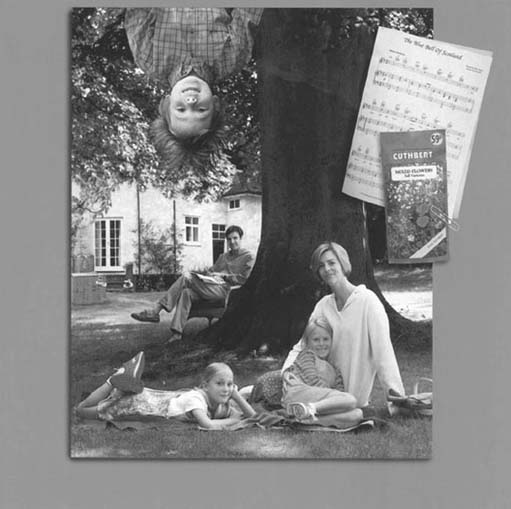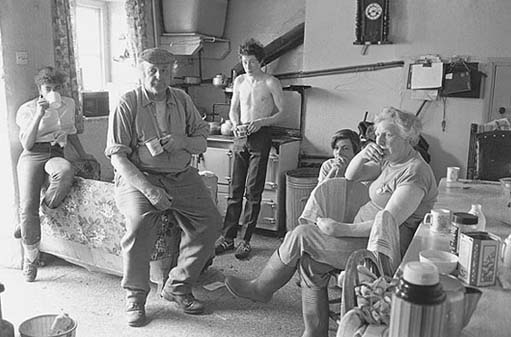3.2 Looking at the family
Activity 3
Look at the photographs in Figures 4 and 5. They depict families in different settings. How would we apply a content/context analysis to them? Make notes on the pictures, particularly with respect to how they deal with questions of identity.
-
What information does the image supply?
-
What can we interpret from the photographs about the nature of the relationships between the people depicted?
-
What are the sources of contextual information that we can bring to bear on the interpretation of the photograph?


Discussion
‘The Bradleys’ seem at first sight to be a relatively ordinary middle-class family. If we saw this picture in the editorial pages of a magazine, we might expect it to be part of a lifestyle feature about a real family and their pursuits. However, as the picture is an advertisement, we would suspect at once that none of the people shown here has any relationship with the others. The information seemingly supplied by the image is contradicted by its context. Or is it? Can we really be sure that this is a collection of ‘models’ rather than a group of related people, a family in the accepted sense? Let's consider what we can derive from a content analysis:
-
The composition of the image. Father sits on a garden chair in the middle distance, next to the trunk of a solid and imposing tree, mother sits on a rug on the grass in the foreground with her two daughters close by her – one snuggles up to the maternal bosom. A boy hangs out of the upper frame of the picture, upside-down in the air (from the branch of a tree?), nearer to the camera. In the background we discern part of a substantial 1930s house, and some tea chests.
-
The implied social order. Apart from the disrupting presence of the boy, there is symmetry and order in the disposition of the family: the distance and higher placement of the father might imply his role as breadwinner, the mother and her daughters seem to be presented in nurturing/nurtured roles. Mother has garden tools near her (but nothing too heavy!) while father has a broadsheet newspaper in his lap (is he a professional/managerial type?). The boy is doing ‘boyish’ things. Wherever we look in the picture there are cues to the social status of the people depicted, and to the gendered structure of the family. You probably do not need us to track down all the stereotypes about identity, but we could add that the nationality/ethnicity cues about the Britishness of the people involved seem to be emphasising their white, middle-class, ‘middle-England’ position.
In the case of ‘The Bradleys’, we as observers are expected to perform a simplistic form of content analysis by virtue of the fact that this is an advertisement. The picture has been designed to create a positive feeling towards the Bradleys. They project aspirational values that the advertiser assumes are congenial to those who read the magazines where the advertisement will be placed. The expectation is that, as viewers, we (or some of us, at least) will identify with the Bradleys, see in them a family that we would like to be part of, and thus be attentive to the message contained in the advert.
If we apply a context analysis to the photograph, we'll begin to flesh out the context of presentation and circulation. However, it will soon be clear that there really is not much to discover. After all, it is only an advertisement and by that very fact we know that the image makes no claims to be socially relevant data. We all know that advertisements are there to persuade us, to offer ideal images that can seduce us to consume a product (or even just recognise a logo!). A context analysis of advertising images would examine those processes within the media themselves that led to the appearance and regular publication of these photographs. It would also examine the creation and definition of a system for making such images on a regular basis, and its wider relationships with the advertising and marketing businesses. It would be concerned with the processes that established the visual conventions of advertising photography. The production of such images presupposes a network of models, agents, and photographers, all specialising in such work. Its economy and organisation are therefore important issues.
Now look at ‘The French family watch the Cup Final’ (‘French’ is the family surname), a picture made in 1985 by James Ravilious as part of a major and long-term documentary project on the people and landscape of North Devon (Hamilton, 1998). This too offers an image of a family. A content analysis of the photograph reveals some information about this family's rural lifestyle. What can it contribute to our interest in identity? You might have noted that the two adults take quite dominant positions in the picture. This is a result of the photographer taking his picture from a position at the side of the television. (Of course we cannot see the television, and indeed we only know that it exists via the information supplied by the photographer.) The young people in the picture are arranged in a mainly subordinate position to the adults, who form a protective barrier between us as viewers, and them, as subjects. All are dressed informally, the adults in what are probably work-clothes: and without knowing that they are farmers, we could easily guess at their way of life. It is hardly aspirational in the sense of ‘The Bradleys’.
The social data available in this photograph will only be supplemented by a context analysis, which would bring in information about its place in the wider project of which it forms a part. Once considered alongside many other pictures of similar people, and supplemented by other information about their way of life, it would contribute some data to a wider sociological understanding of the structure of North Devon's rural society. At the same time it would provide an appreciation of the agency of the people involved. We would also need to know something about the work of the photographer, why and how he made such images. Space precludes further exploration here, but it is relevant that Ravilious was interested in photographing as much as possible the ordinary nature of the people and places that formed his subjects, and in the ways in which that expressed an ethnic ‘Englishness’, typical of this area of North Devon.
